Sasaki Leading Design for Europe’s Largest Coastal Park
The Ellinikon Park will be a new social, recreational, and ecological hub for Athens, Greece
 Sasaki
Sasaki
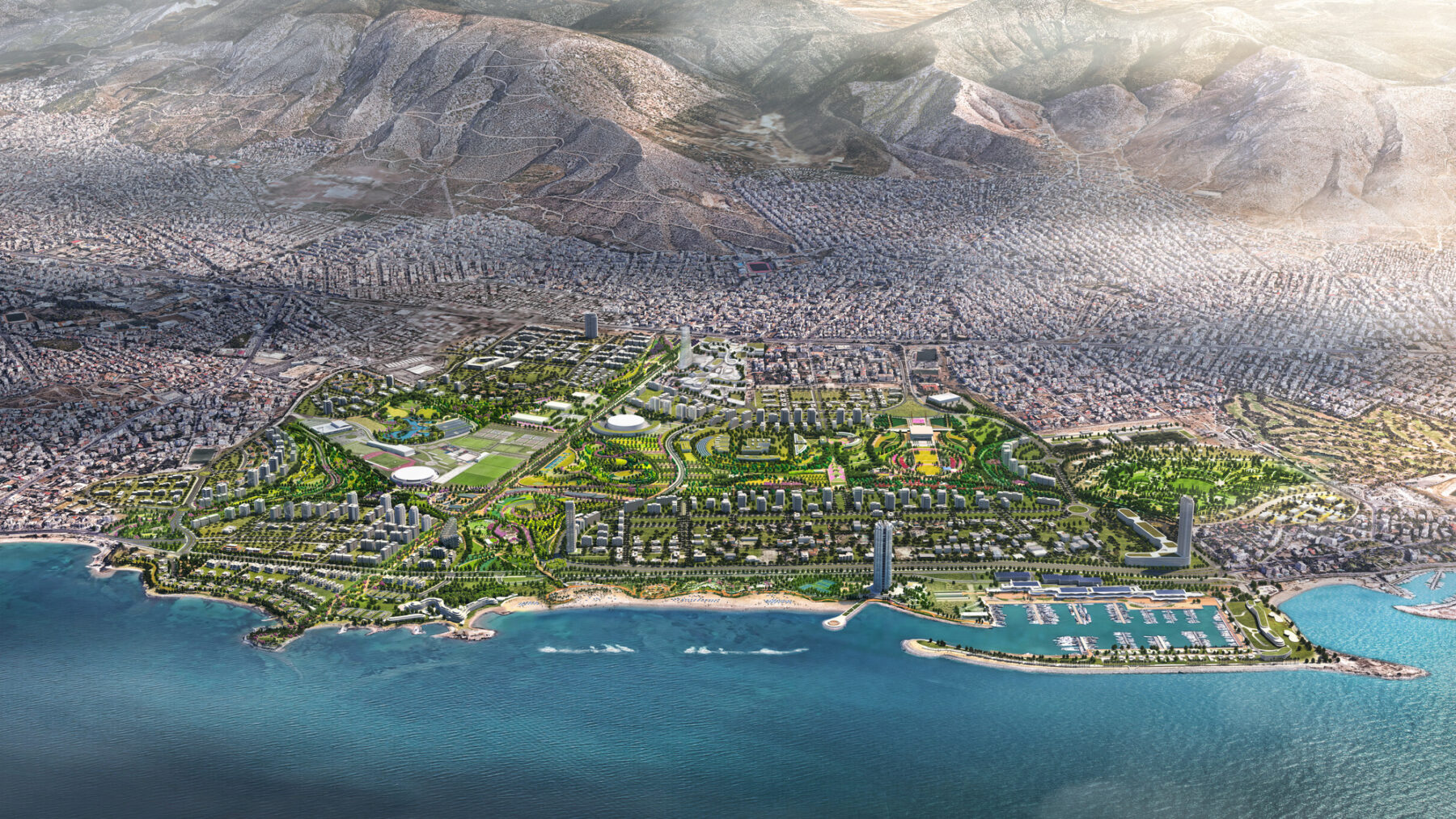
Currently the largest urban redevelopment project in Europe, the Ellinikon alleviates development pressure away from the historic core of Athens. The 243-hectare (600-acre) Park is the centerpiece of a mixed-use district that will create a new center of gravity for the city.
The Ellinikon Park is poised to become one of the most significant public spaces in Athens—an ambitious goal for a city celebrated for its iconic architecture and urban design. This park, however, is special. It will set a new standard for ecological restoration and will model a cutting-edge approach for the design, programming, and funding of future public parks across the world.
The design embraces the site’s abundant cultural heritage while establishing a 21st century ethos and identity for Athens that will resonate for the next 1,000 years. Once complete, the park will become the social heart of Athens and will provide novel experiences for visitors in a city that does not have a public park at this scale.
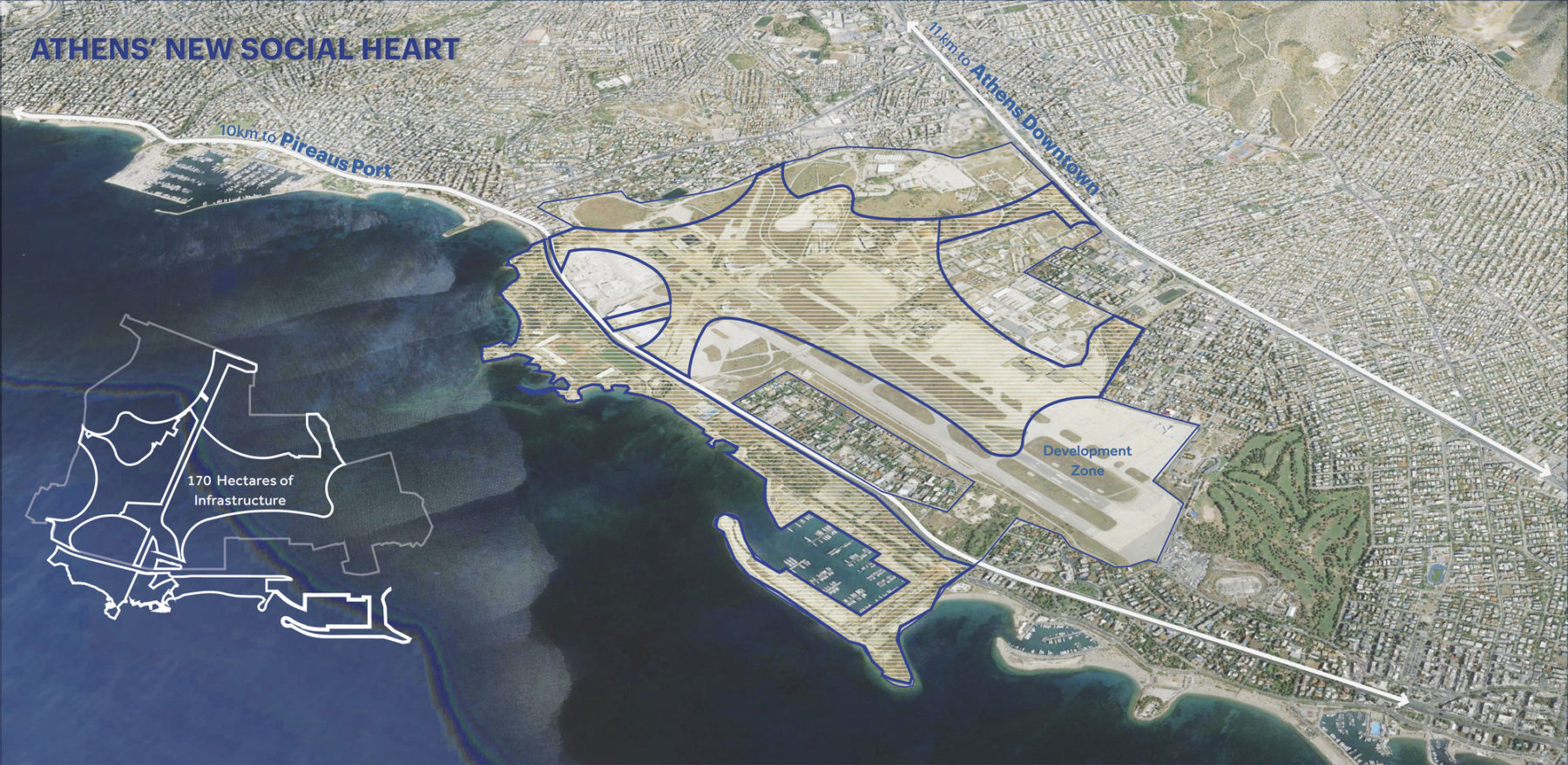
The decommissioning of the original Athens International Airport in 2001 led to two decades of work to create a funding and governance mechanism that would transform the city’s largest piece of obsolete infrastructure into Europe’s largest coastal park
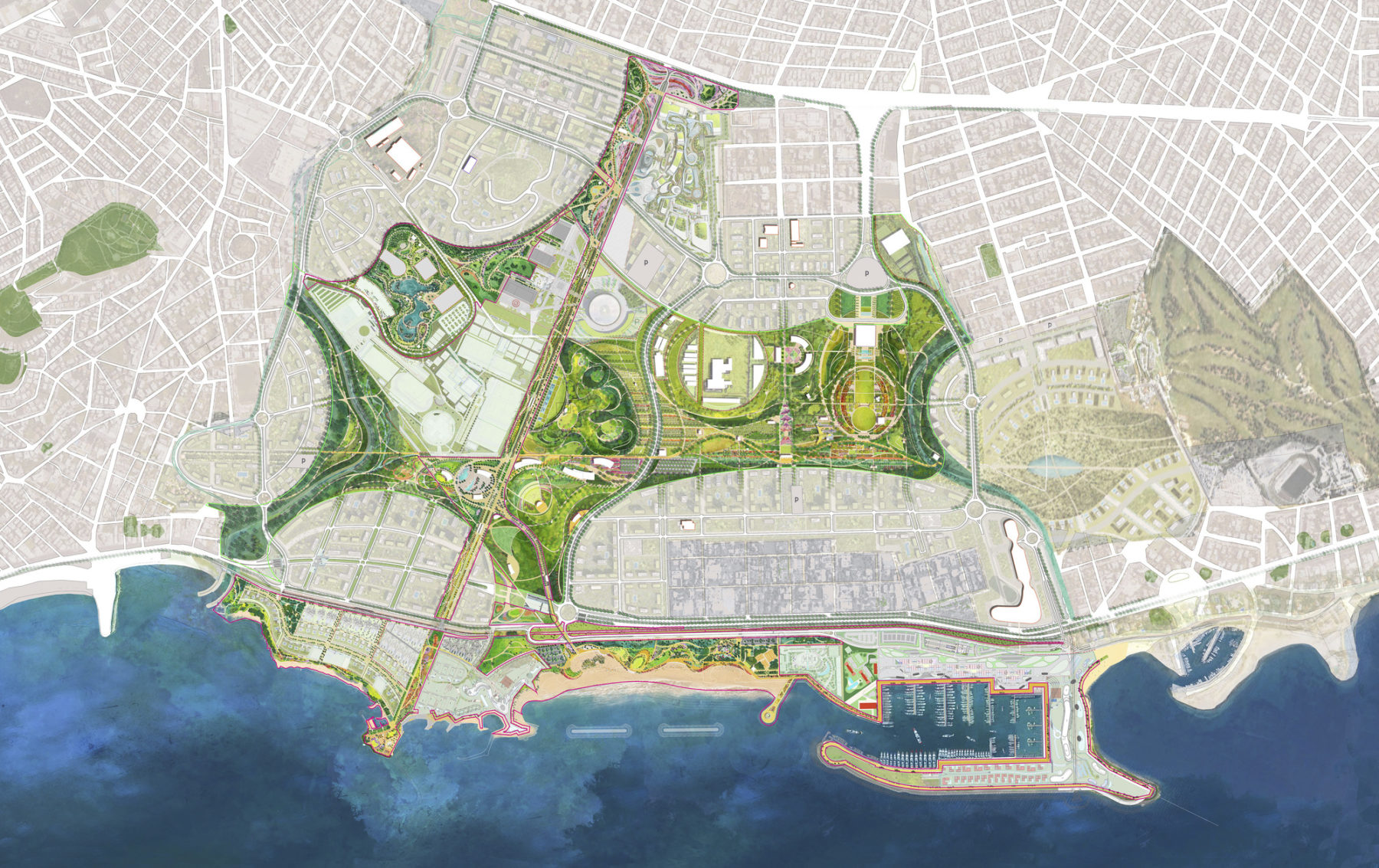
The Ellinikon is heroic in scale and ambition, which translates into a responsibility to reinforce the Greek relationship with landscape and reignite this ethos in a 21st century context, centering ecological restoration, carbon neutrality, and equitable access for all Athenians
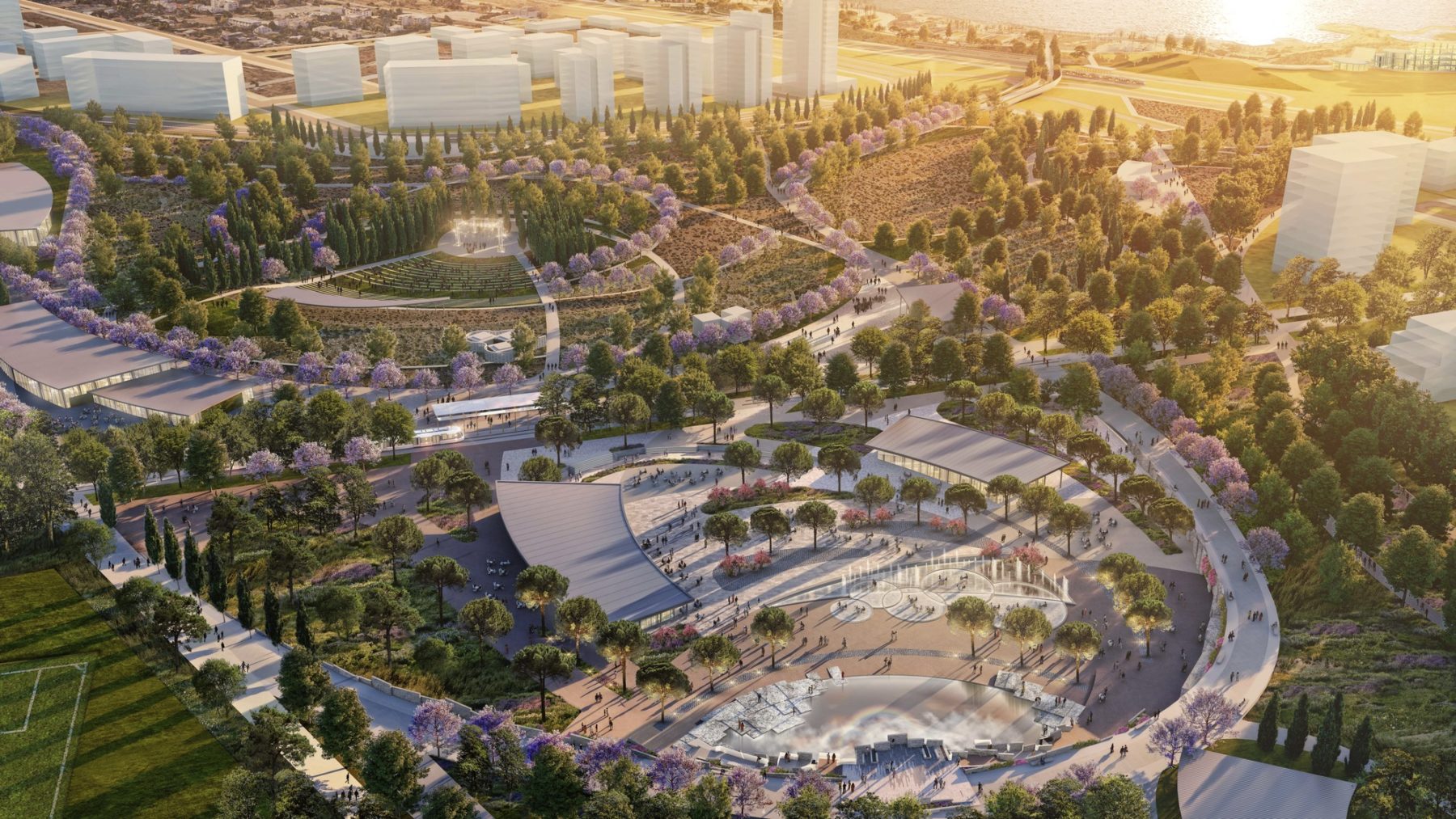
The cluster of destinations surrounding Olympic Square includes iconic fountains, food and beverage venues, an amphitheater for outdoor performances, and an Olympic-themed destination playground, providing familiar uses while illustrating how contemporary Greek life is rooted in ancient traditions
Throughout history, the site has been an inclusive, publicly accessible space ingrained in the collective memory of Athenians. After the decommissioning of the Athens International Airport in 2001, a funding and governance mechanism was established that would transform the abandoned space into Europe’s largest coastal park. The 243 hectare (600 acre) park is bigger than the entire principality of Monaco and represents a palimpsest of Athenian landscapes including prehistoric coastal settlements, productive agricultural fields, a 20th century airport, and a 21st century Olympic venue.
Greek society, however, is undergoing an unprecedented shift in demographics, enhanced by the economic crisis of 2008-2010 which accelerated brain drain and shifted entrenched societal standards. Historically, Athenians returned to family farms in the countryside on weekends, but as the Greek diaspora grew abroad, most contemporary Athenians no longer had access to a rural ancestral home, displacing the traditional cultural relationship with the landscape. Today, the majority of open spaces in Athens are either passive landscapes adjacent to ancient ruins or hyper-urban plazas and streetscapes. Working within this context, a foundational goal for the park is to engage Athenian society in a 21st century landscape that reinstates a relationship with nature and demonstrates Greece’s commitment to climate positive design.

The majority of existing open spaces in Athens today are either passive landscapes adjacent to ancient ruins, or hyper-urban plazas and streetscapes. The Ellinikon is an opportunity to reconnect the citizenry with nature, and to rekindle a cultural affinity for the Greek landscape. Moreover, it will increase the allocation of open space per resident in Athens by 44%.
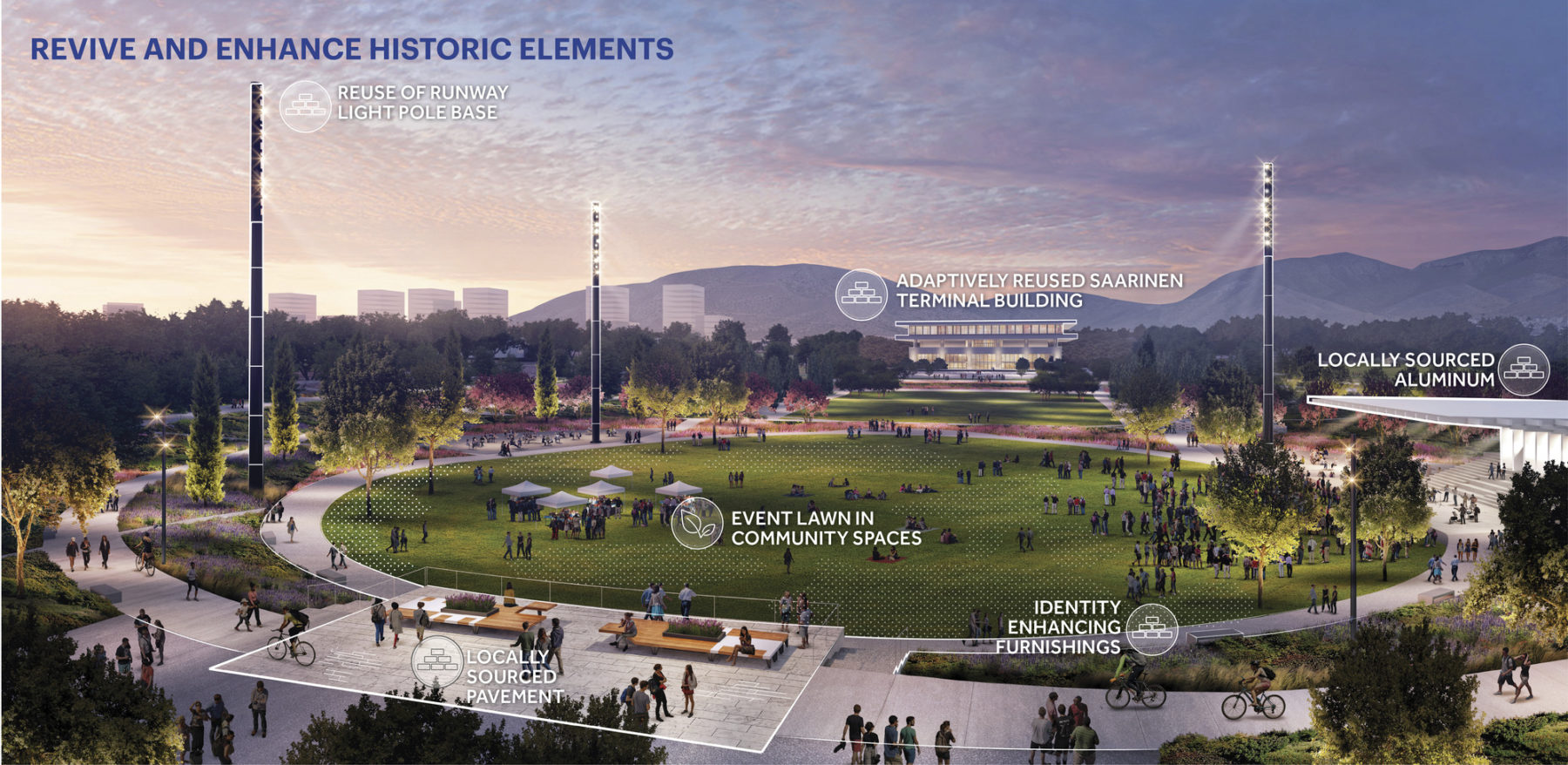
One of only three airports in the world designed by Eero Saarinen, the adaptively-reused terminal building is the centerpiece of a grand event space. In addition to preserving the terminal, massive light poles for the former airport and concrete from the runways are reused throughout the park.
While the airport and Olympic histories provide an underlay for formal moves, natural systems offer opportunities to diverge from the rigid forms of the existing infrastructure. This duality has a direct translation to form giving. Curvilinear and organic visual languages highlight restored ecosystems and topography, and linear expressions reveal the site’s legacy of airport runways, its 2004 hosting of the Olympic Games, and its agricultural heritage. Most notably, the park presents an opportunity to restore vital habitat and ecosystem functions, balancing cultural expression with robust renaturalization.
While the site lacked maintenance for nearly two decades, a novel ecosystem emerged. While it is not possible to restore the landscape to a pre-anthropic ecological assemblage, rigorous analysis identified foundational plant species that provide key ecological benefits like habitat structure and food provisioning for local wildlife. Over 30,000 new trees representing 86 species were selected for their ecosystem services and adaptability to the site’s distinctive soil profile. The plant list was carefully considered based on 1) native status; 2) adaptability to local and regional climatic conditions; and 3) current distribution range in the Mediterranean basin and known occurrence on the Attica peninsula.
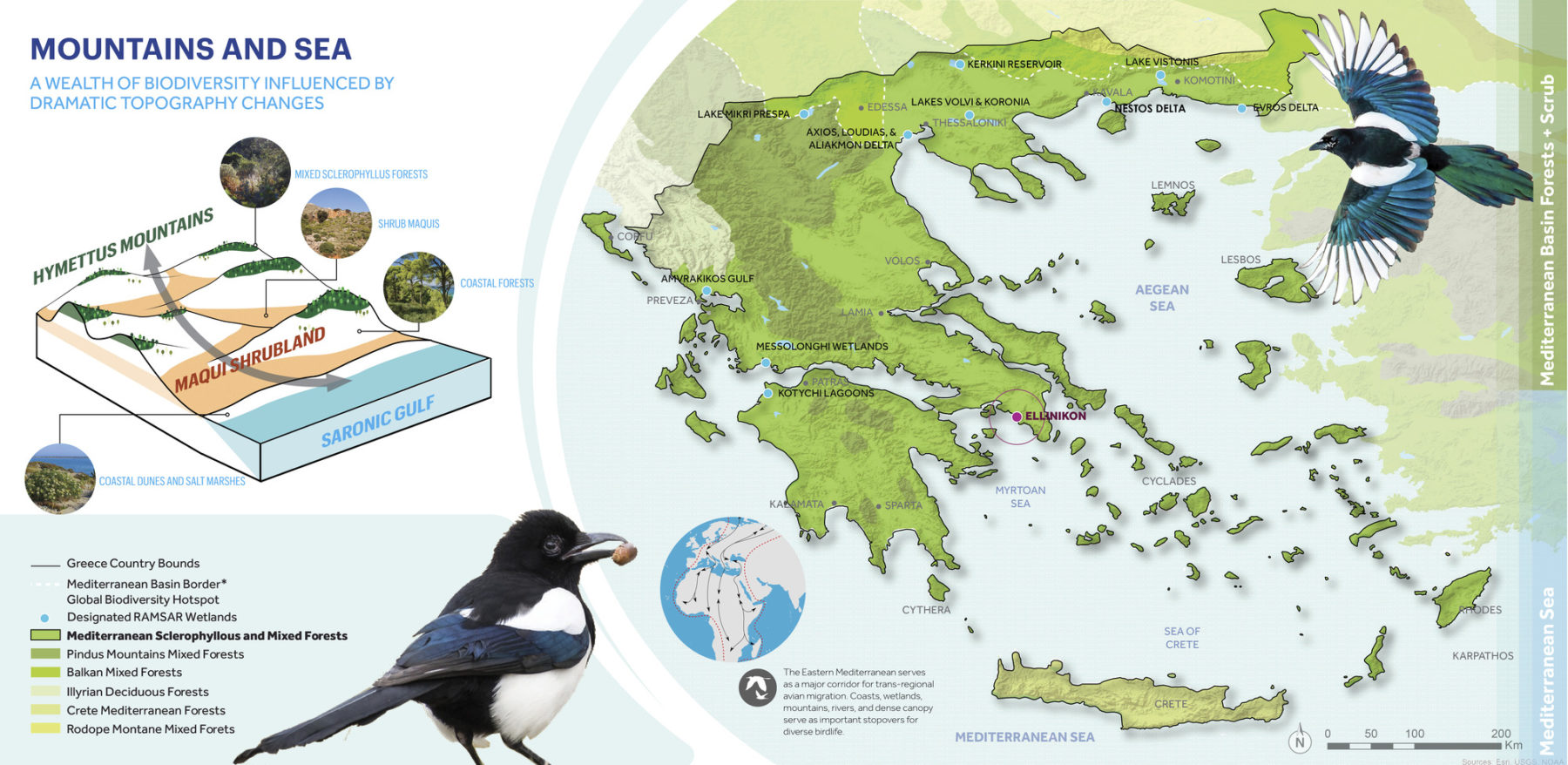
The Ellinikon Park is centered in a biodiversity hotspot. Foundational plant species were selected to create associations between locally found insect, bird, and mammal species, and provide multiple ecological benefits including habitat structure and food provisioning throughout the year.
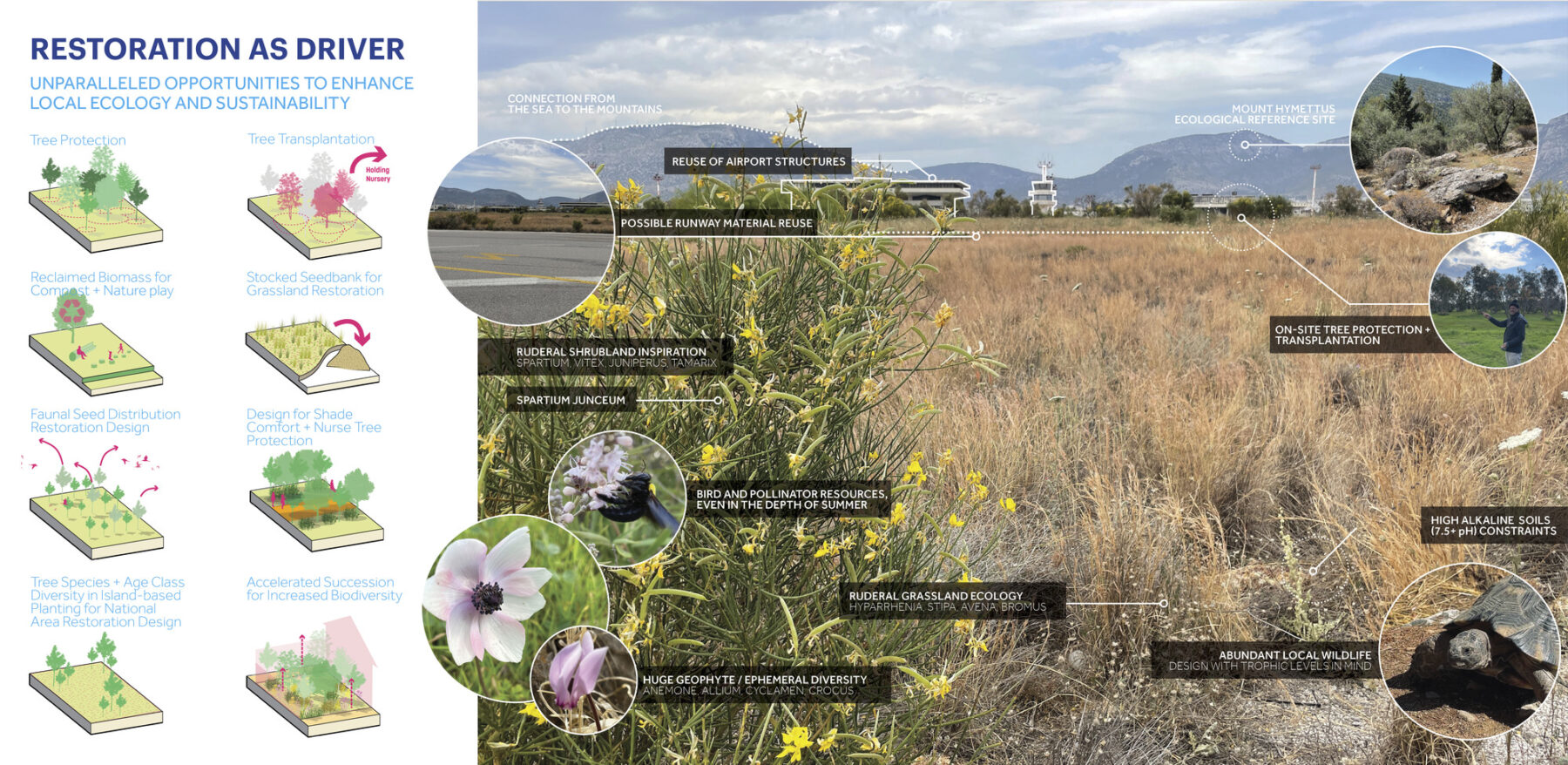
Ecological restoration strategies included exclusive use of native and adapted species, in-situ tree preservation, reuse of removed trees as landscape features, planting in groups for accelerated succession, saving the successional seed bank, and biomass management for fire protection.
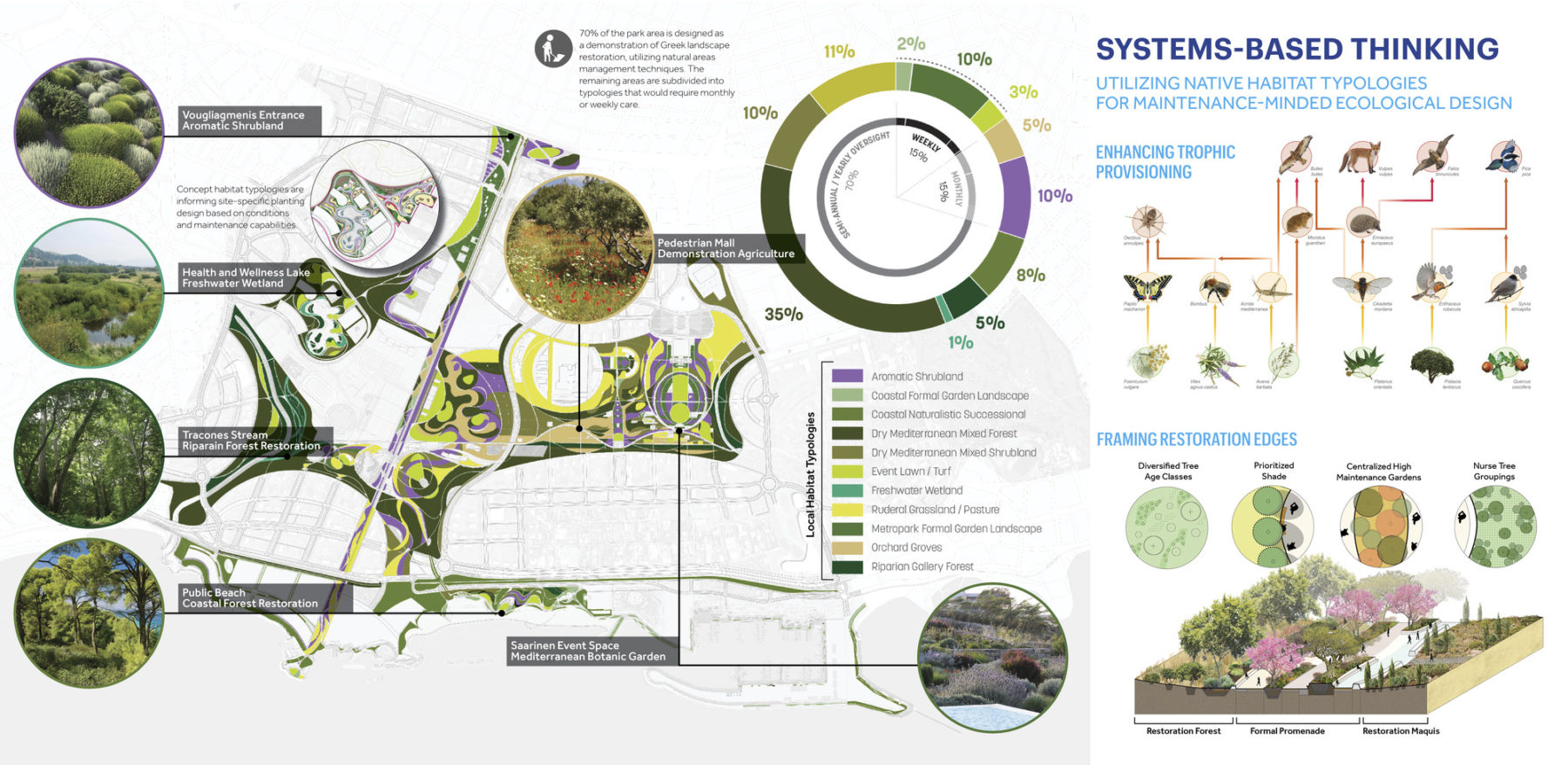
70% of the park is designed as a demonstration of Greek landscape restoration, utilizing natural areas management techniques. The remaining 30% is focused around high human contact areas and is strategically subdivided into zones that require weekly or monthly care, merging maintenance-minded and habitat-centered design strategies.
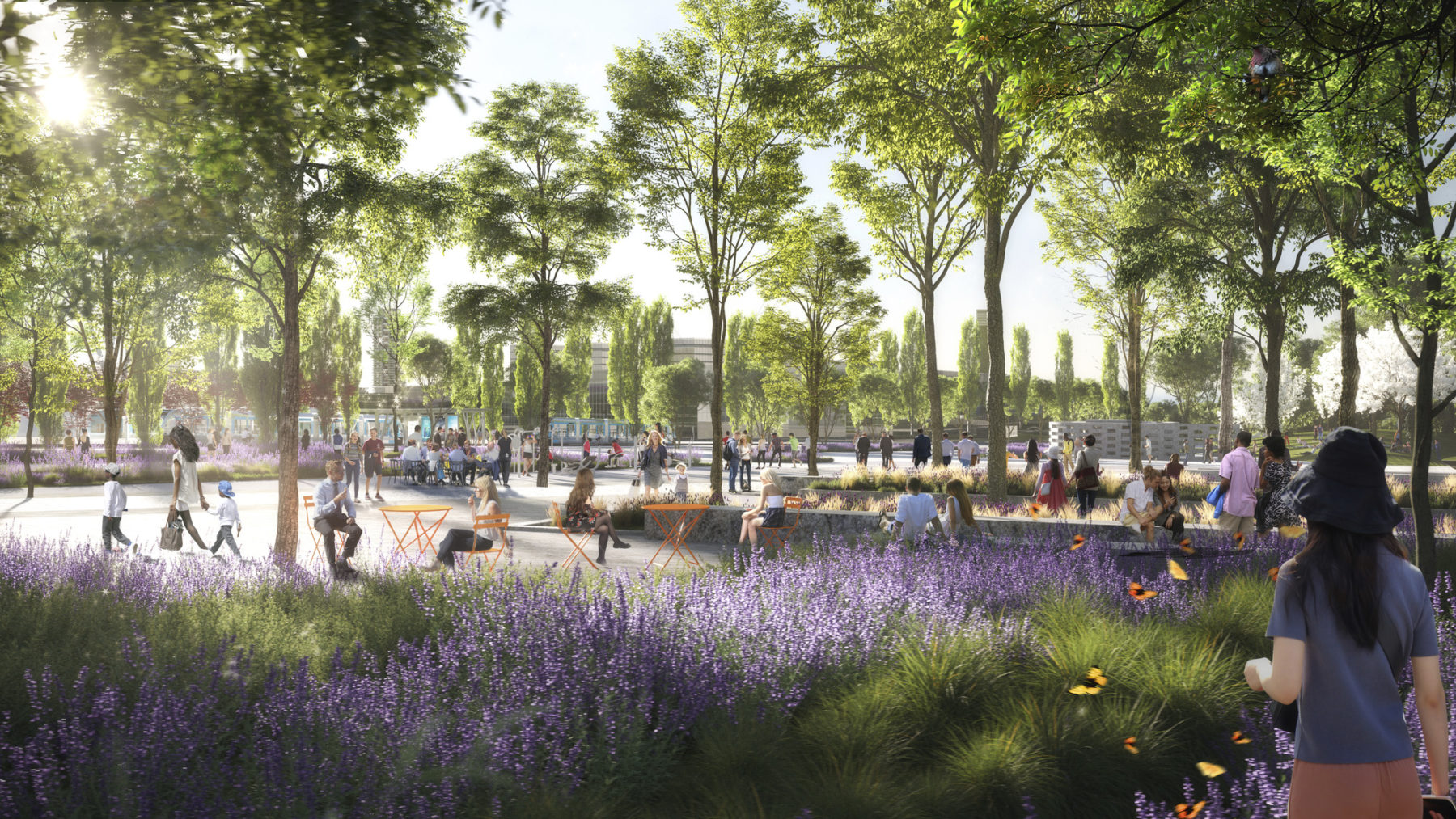
The eastern entrance of the park from Vouliagmenis Boulevard is the beginning of a grand pedestrian axis that extends to the sea. Adjacent to the axis is a series of aromatic gardens, plazas, and sports courts that serve as an intimate neighborhood park.
Plant materials are sourced entirely within Greece, which increases biodiversity and establishes a regenerative landscape strategy. Water scarcity is also a concern, requiring strategies to enhance water management and conservation. 100% of the irrigation water demand for the park is fulfilled through reclaimed water. Additionally, a 1.5 hectare (3.7 acre) lake repurposed from the former canoe/kayak Olympic venue collects and stores stormwater during the wet season, with reclaimed water offsetting evaporation during the dry season. The lake includes a recirculating flow-through wetland and serves as an emergency reservoir for drought and fire control. The combination of the constructed wetland, rain gardens, and bioswale network will make this the largest green infrastructure installation in Greece.
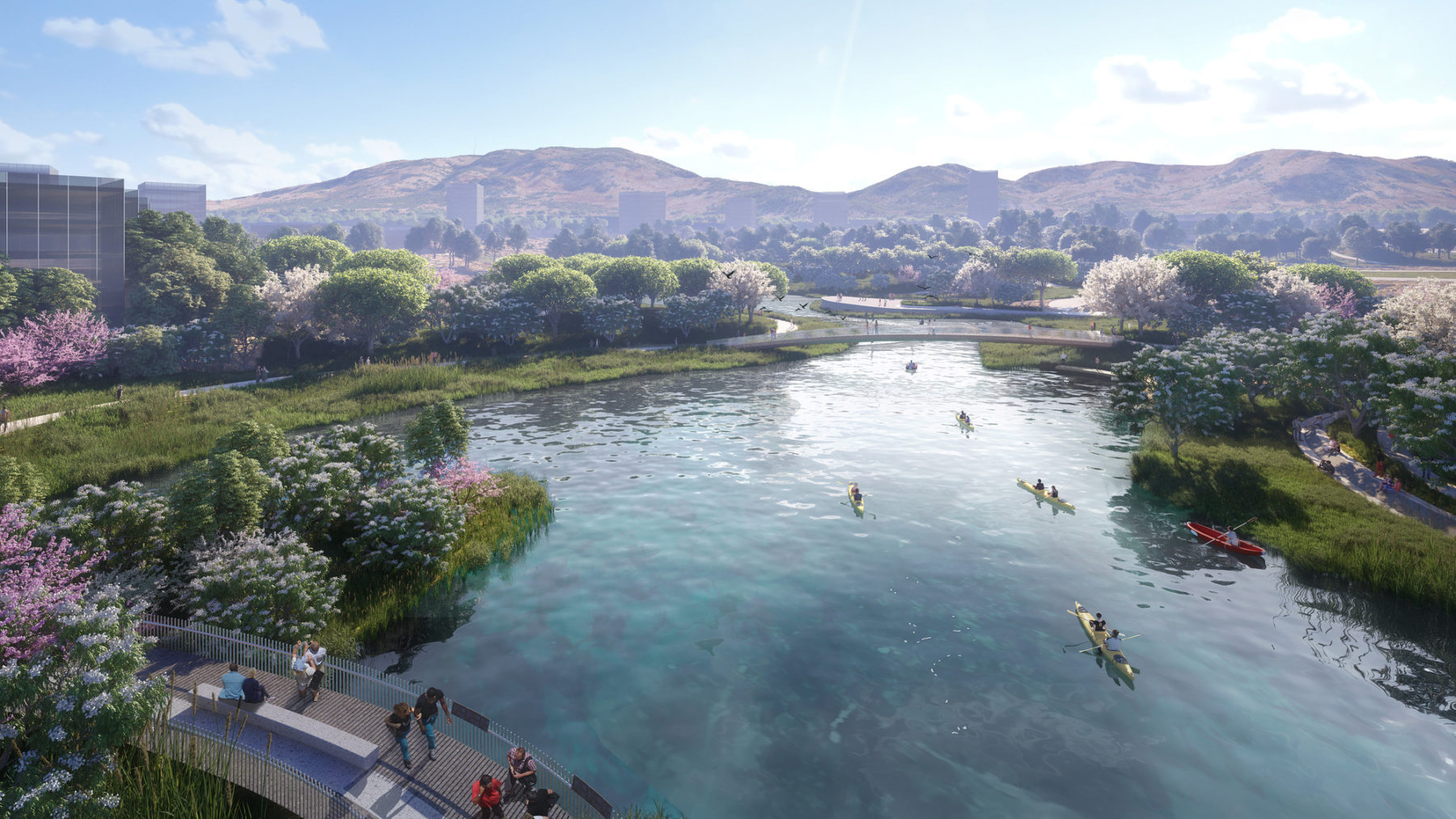
A 1.5 hectare (3.7 acre) lake repurposed from the former canoe/kayak Olympic venue collects and stores stormwater during the wet season, with reclaimed water offsetting evaporation during the dry season
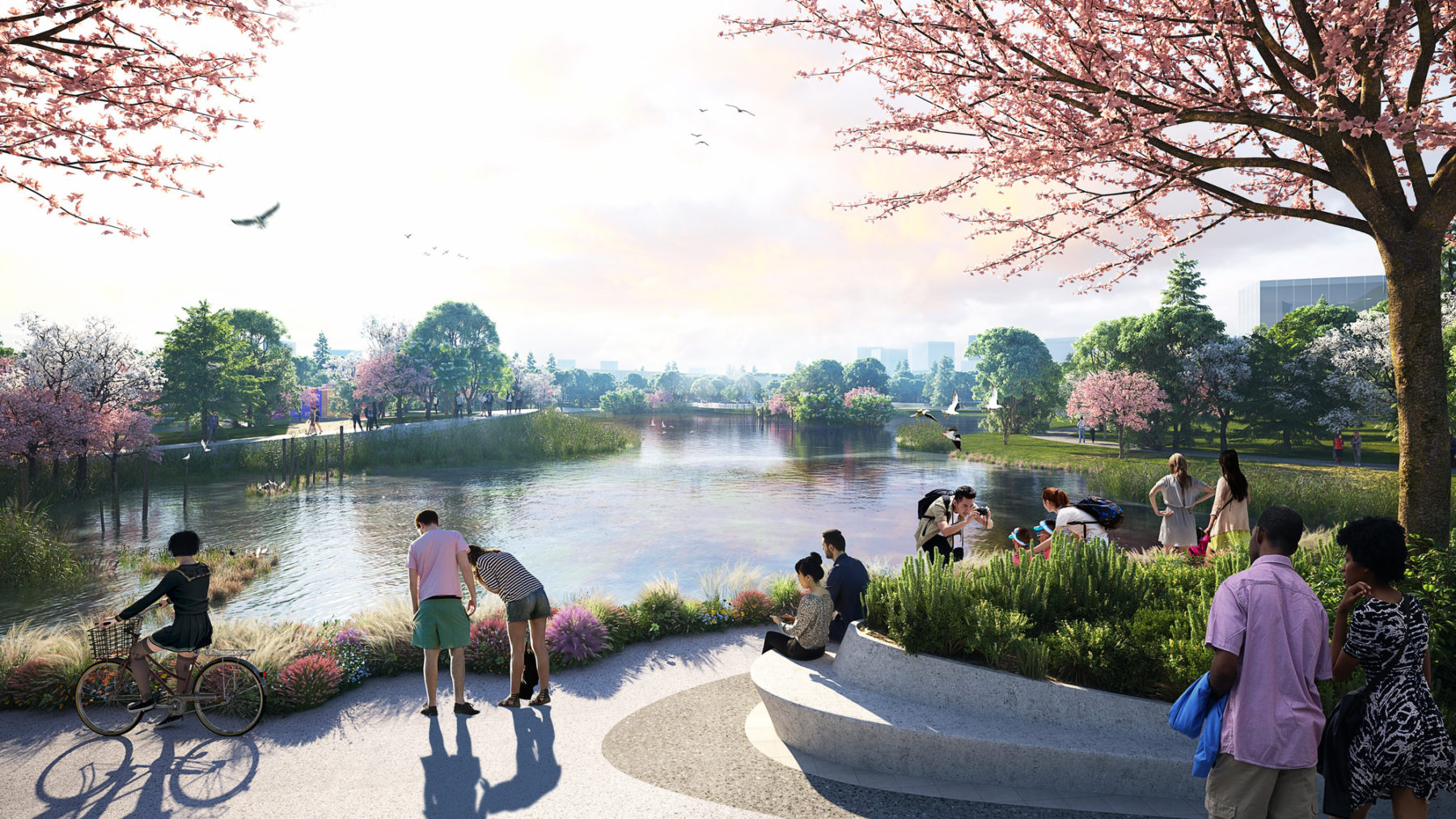
The lake and its surrounding landscape prioritizes ecological restoration and creates a health and wellness retreat including non-motorized boating, yoga, meditation, outdoor classrooms, and nature-based play
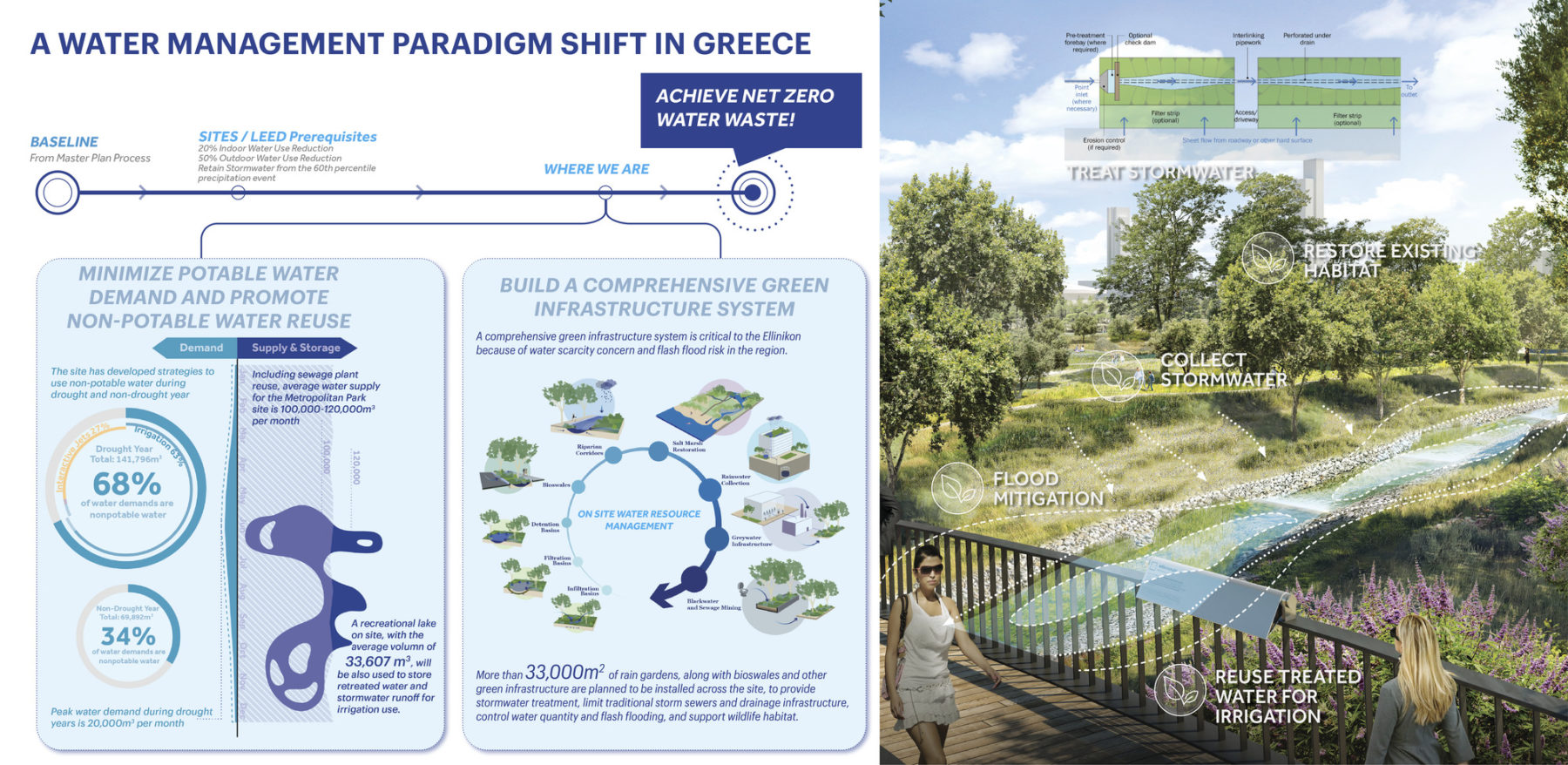
Due to its dry Mediterranean climate, water scarcity in Greece is a significant concern and required strategies to enhance water management and conservation
In addition to committing to a native palette for the park’s more than 3.3 million plants, the design team collaborated with Greek nurseries to create native seed mixes, increasing genetic diversity of plantings while also establishing a new standard for the industry to lead Greece towards a more sustainable nursery trade. The design also ensures that landscapes are continuously showcasing floral interest, even in the depths of summer and winter when Athenian landscapes are typically dormant.
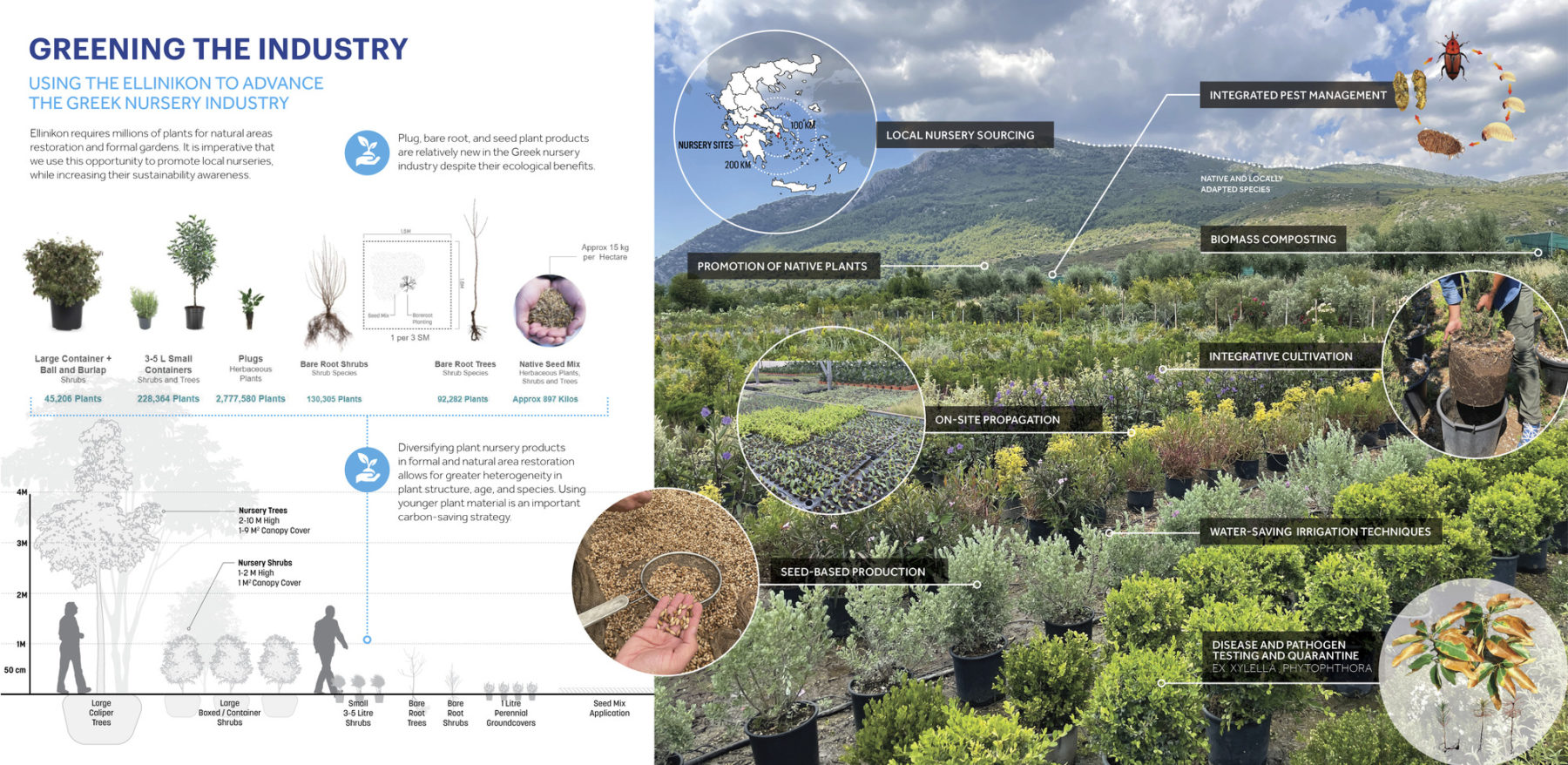
With over 3.3 million plants, the scale of the park presents challenges with procurement. The design team collaborated with local suppliers to create native seed mixes and plantings that established a new sustainable standard for the Greek nursery industry.
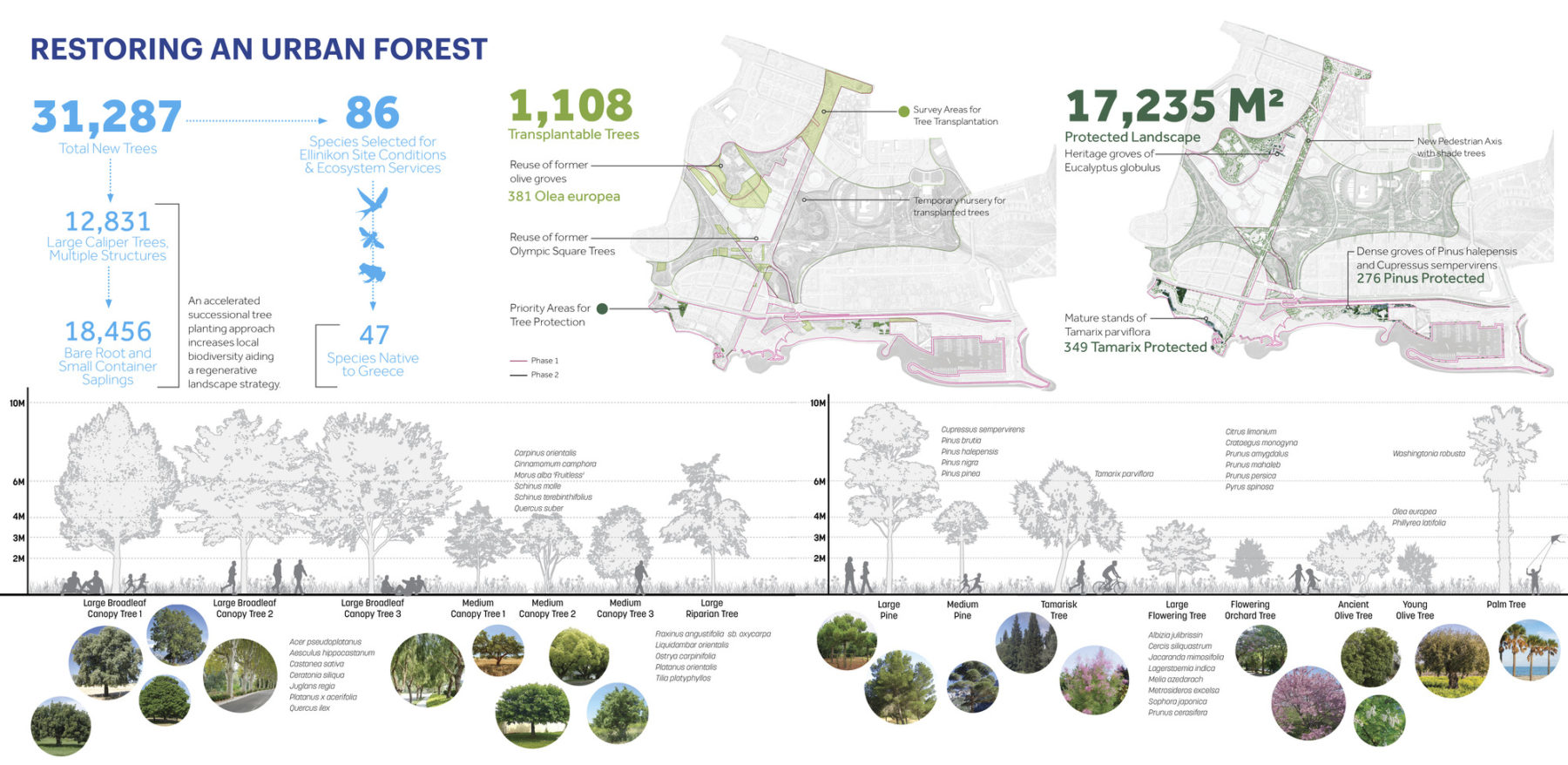
To establish an urban forest, over 31,000 trees representing 86 species were sourced entirely within Greece and were selected for their ecosystem services and adaptability to the site’s alkaline soils. An accelerated succession approach also increases biodiversity and establishes a regenerative landscape strategy.
The team prioritized using durable, reusable, and long life-cycle materials that reduce the overall carbon footprint of the park. With an abundance of leftover materials from the site’s past lives, what would typically be discarded was repurposed and celebrated.
Using the Carbon Conscience and Pathfinder tools, design decisions were based on increasing sequestered and stored carbon and reducing embodied carbon. With this in mind, 28,720 m2 (309,140 sq. ft.) of concrete from the existing airport runways and tarmac is reused playfully throughout the park to subtly tell the story of the site’s past, transforming the banal into something beautiful.
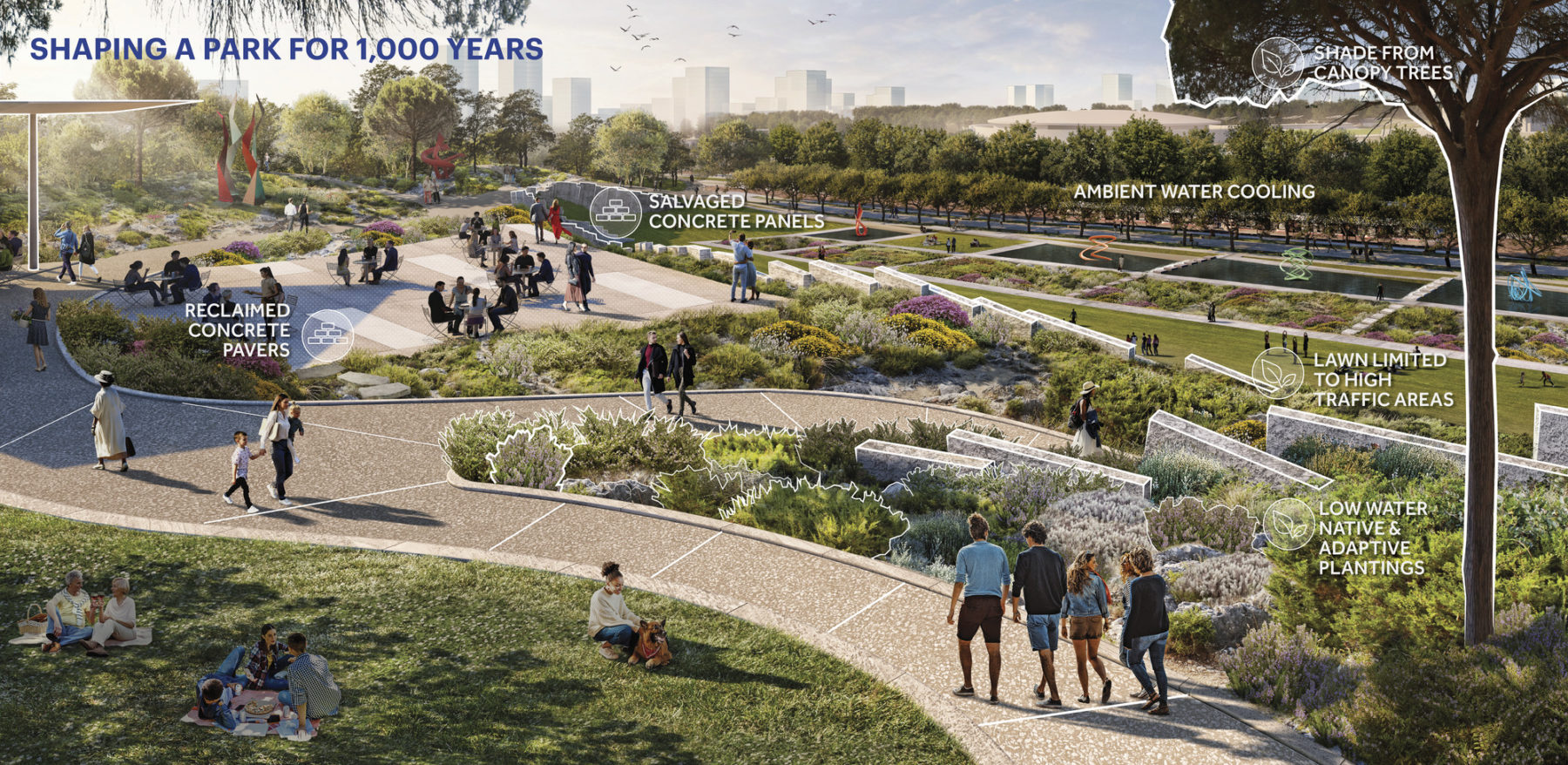
The park is intended as a public space that will serve the city and continue to evolve over centuries. Just as the classic architecture of Athens has withstood the test of time, durable materials and climate adaptive plantings were prioritized.
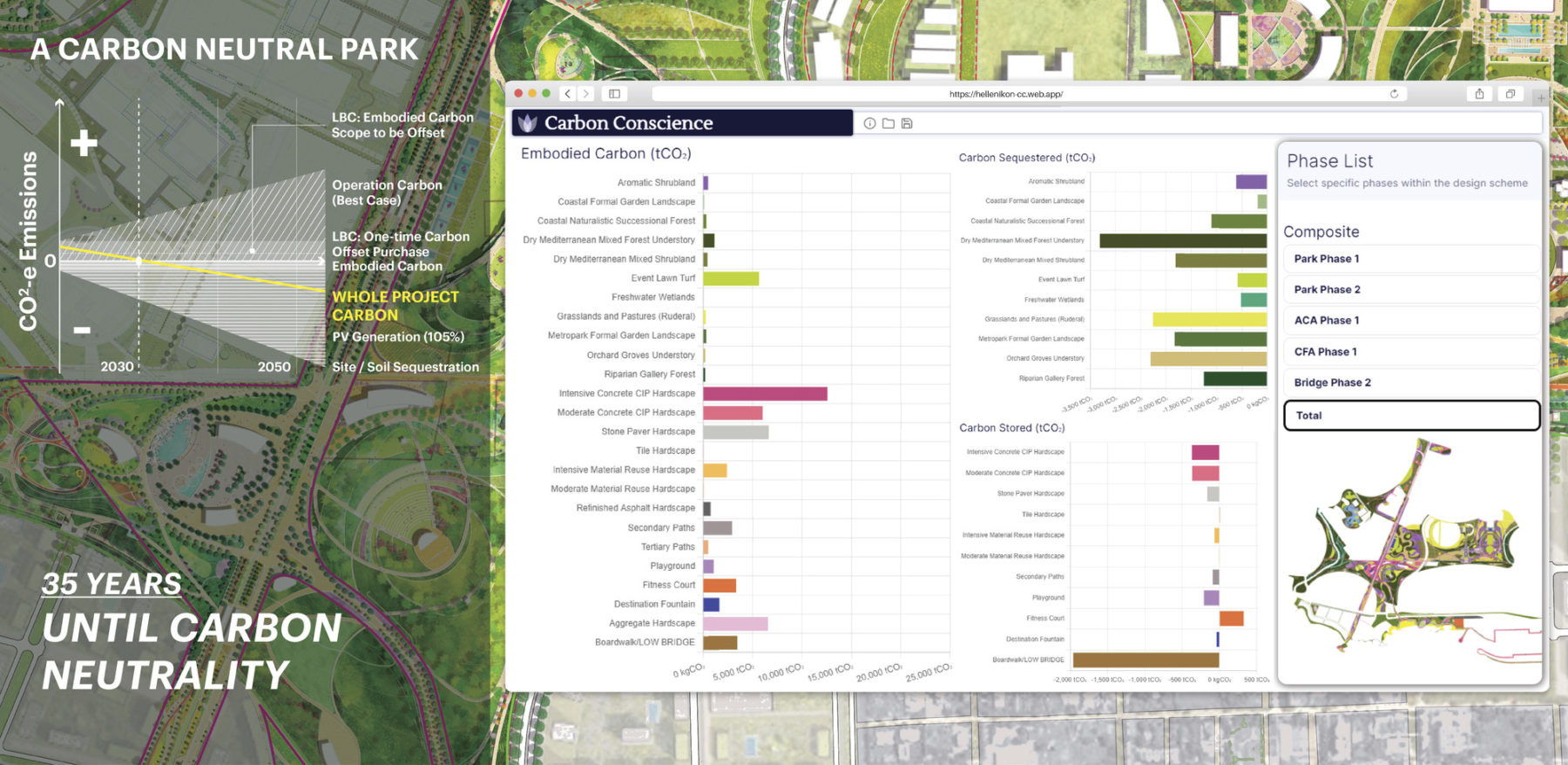
Using the Carbon Conscience tool, design decisions were based on increasing sequestered and stored carbon and reducing embodied carbon. Material selections centering on mining concrete from the airport runways for reuse, and developing an appropriate planting palette enables the park to reach carbon neutrality within 35 years.
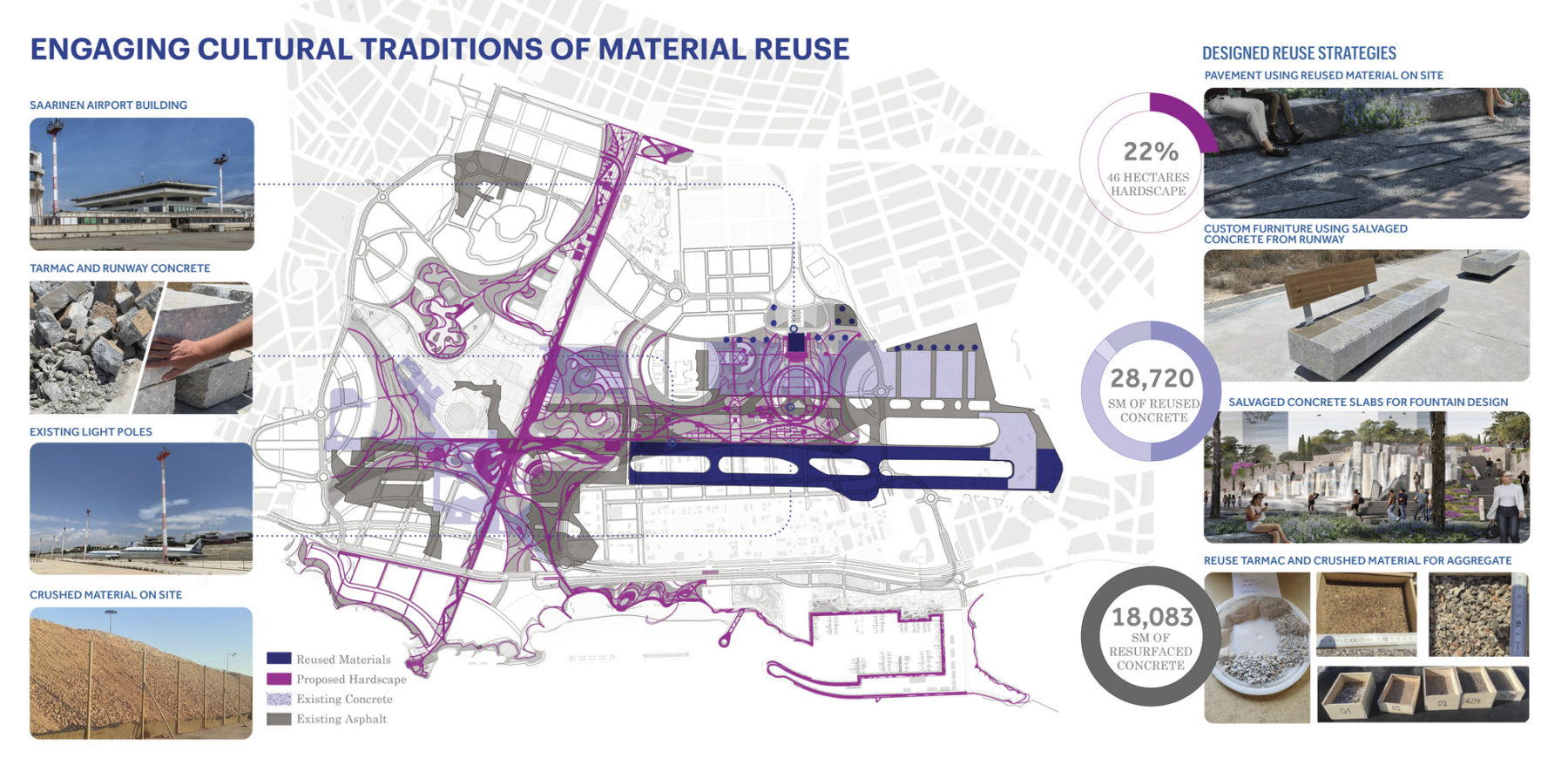
With an abundance of leftover materials from the site’s past lives—most notably the airport runways—what would typically be discarded was reused, recycled, repurposed, and celebrated to reduce the project’s overall embodied carbon
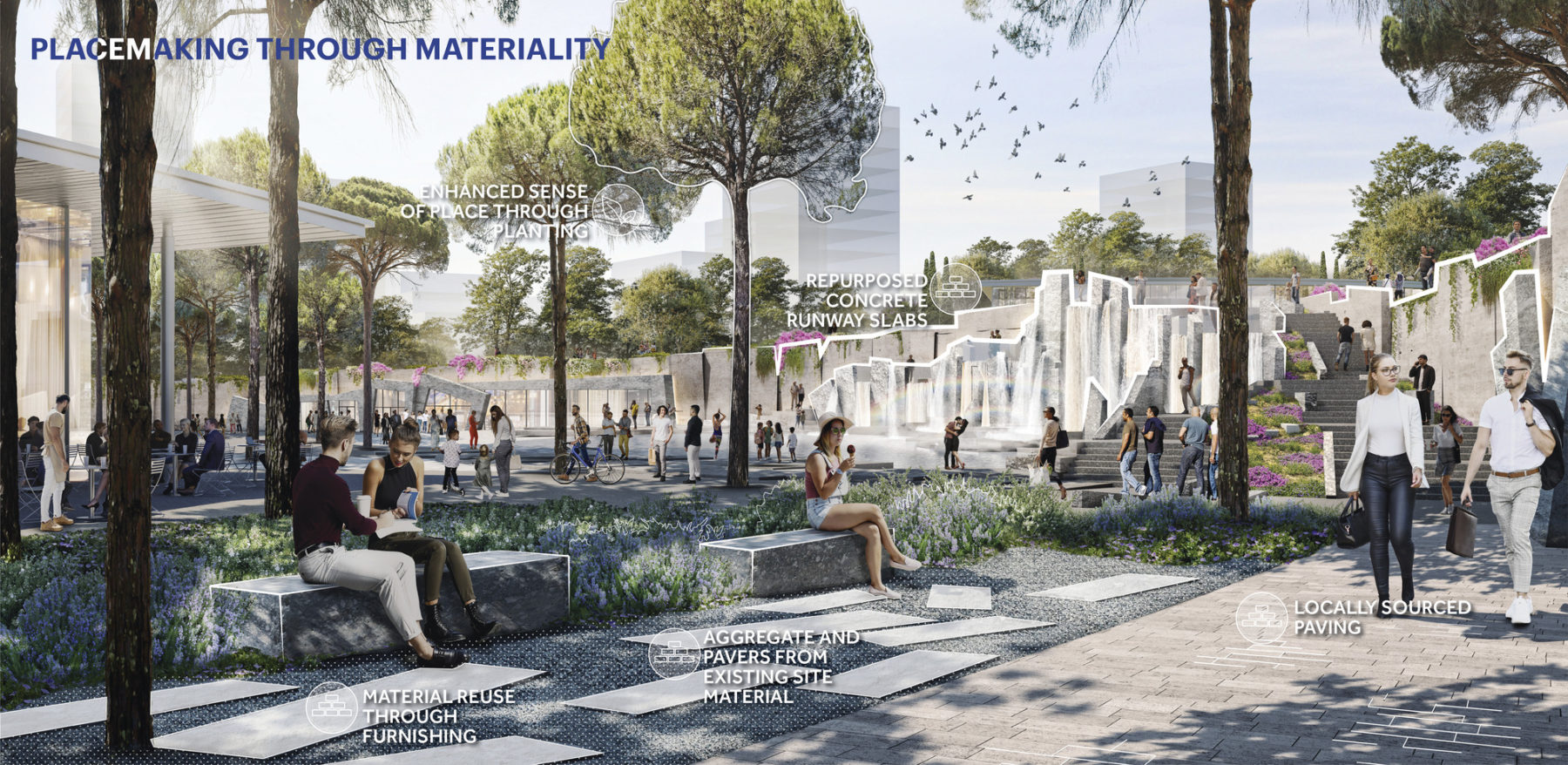
Approximately 30,000 square meters of concrete from existing runways is reused playfully throughout the park to subtly tell the story of the site’s past. With its glimmering marble aggregate, what was once underground and unseen is honored.
The Ellinikon Park will reach carbon neutrality within 35 years—a remarkable achievement for a project of this scale. The park is a landscape that embodies regenerative design, and will have a significant impact on Athens from a climate perspective. Through all aspects of the design—from soil management, material reuse, water systems, food and energy production, and habitat creation—the park is a working landscape. It is heroic in scale and ambition, which translates into a responsibility to reinforce the Greek relationship with landscape and reignite this ethos in a 21st century context—centering ecological restoration, climate responsiveness, carbon neutrality, and equitable access for all Athenians. Most importantly, it is a highly visible civic platform that embodies a commitment by the Greek people to provide a progressive model for a landscape that symbiotically benefits people and the planet.
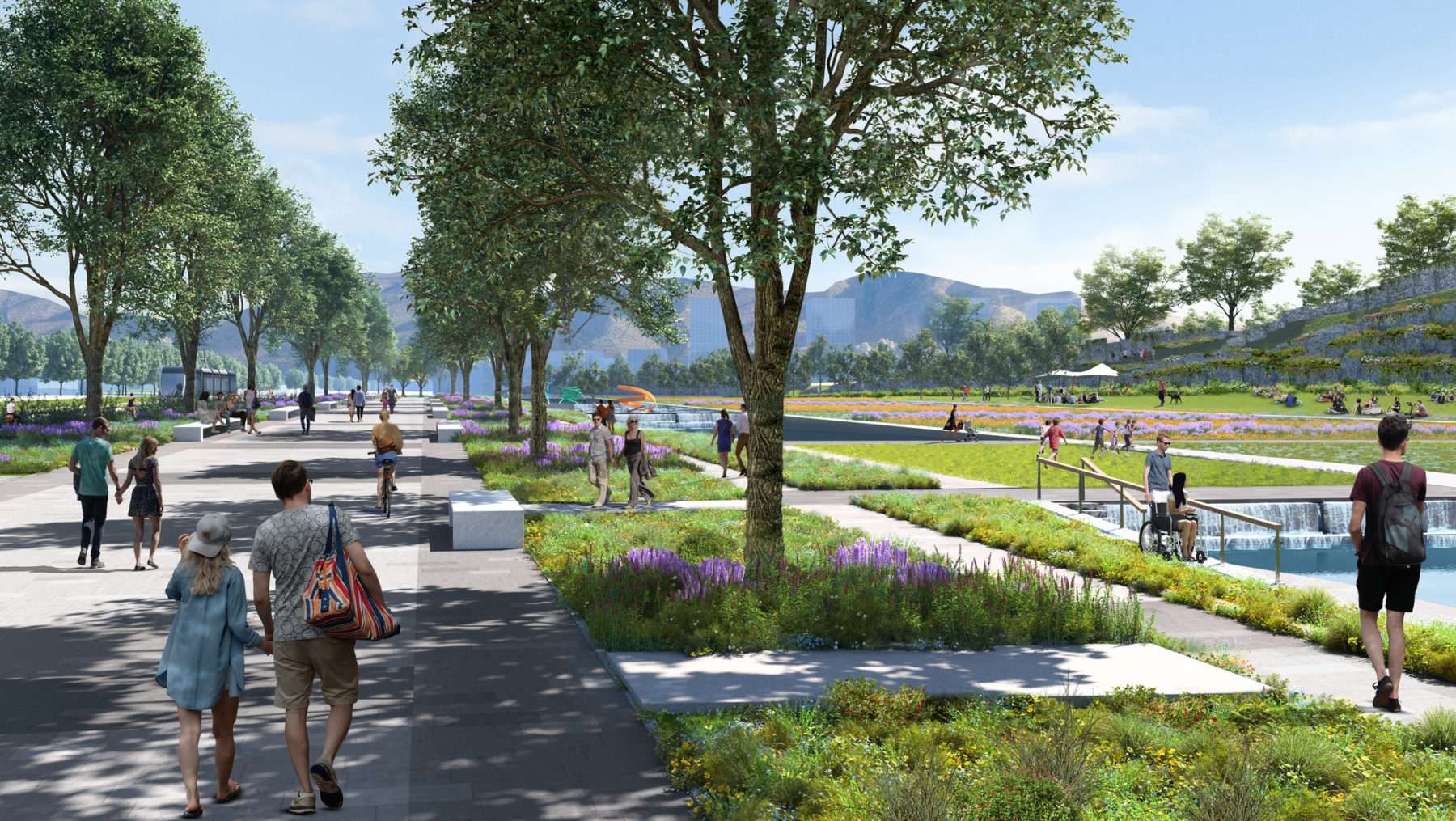
A 2.2 kilometer (1.4 mile) long pedestrian axis links the Ellinikon Park with the sea. Designed for users moving at different speeds, the axis accommodates pedestrians, cyclists, as well as an extension of the Athens Coastal Tram.
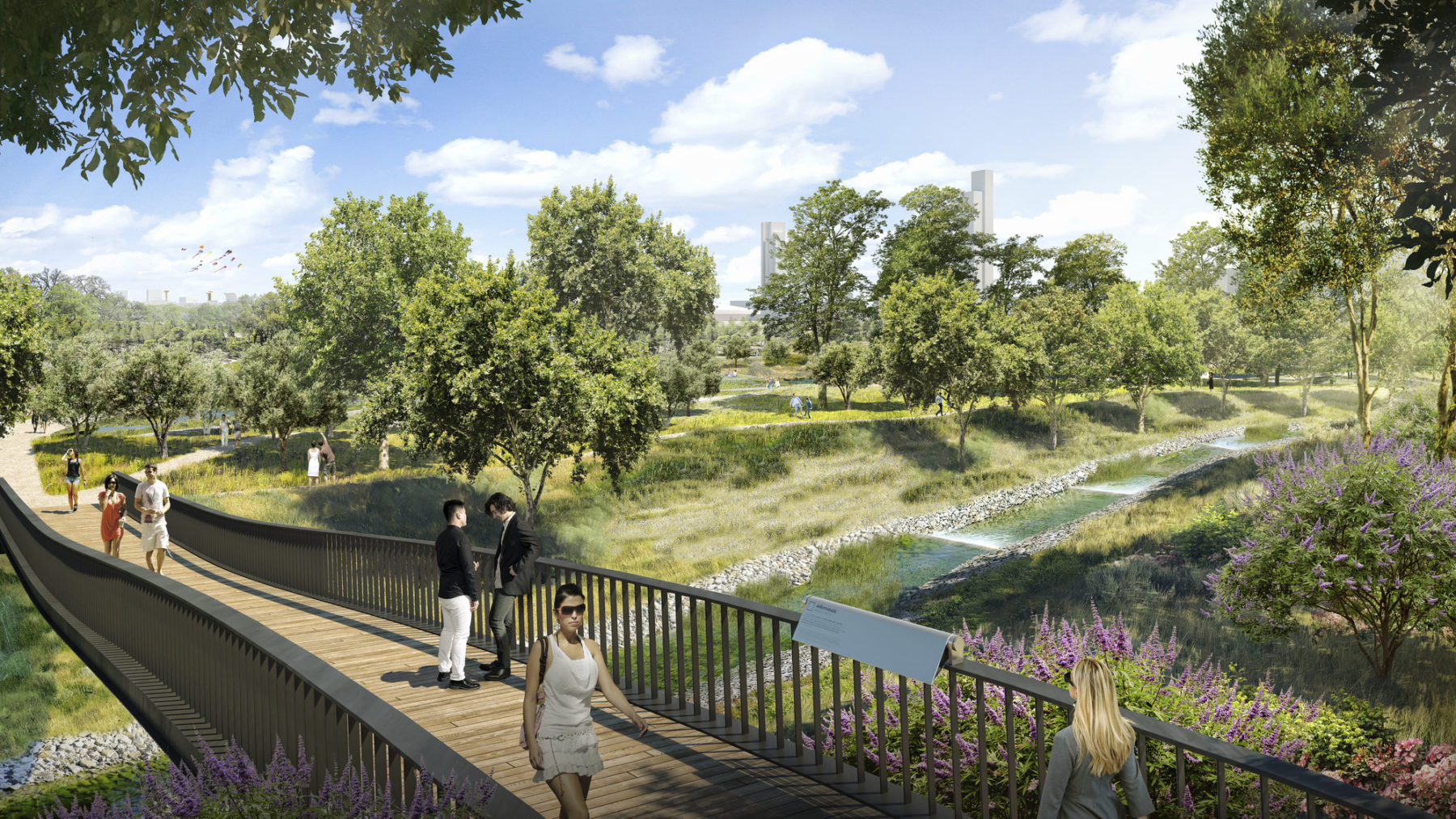
The Tracones Stream is an important ecological corridor connecting the Hymettus Mountains to the Saronic Gulf and helps to manage regional stormwater
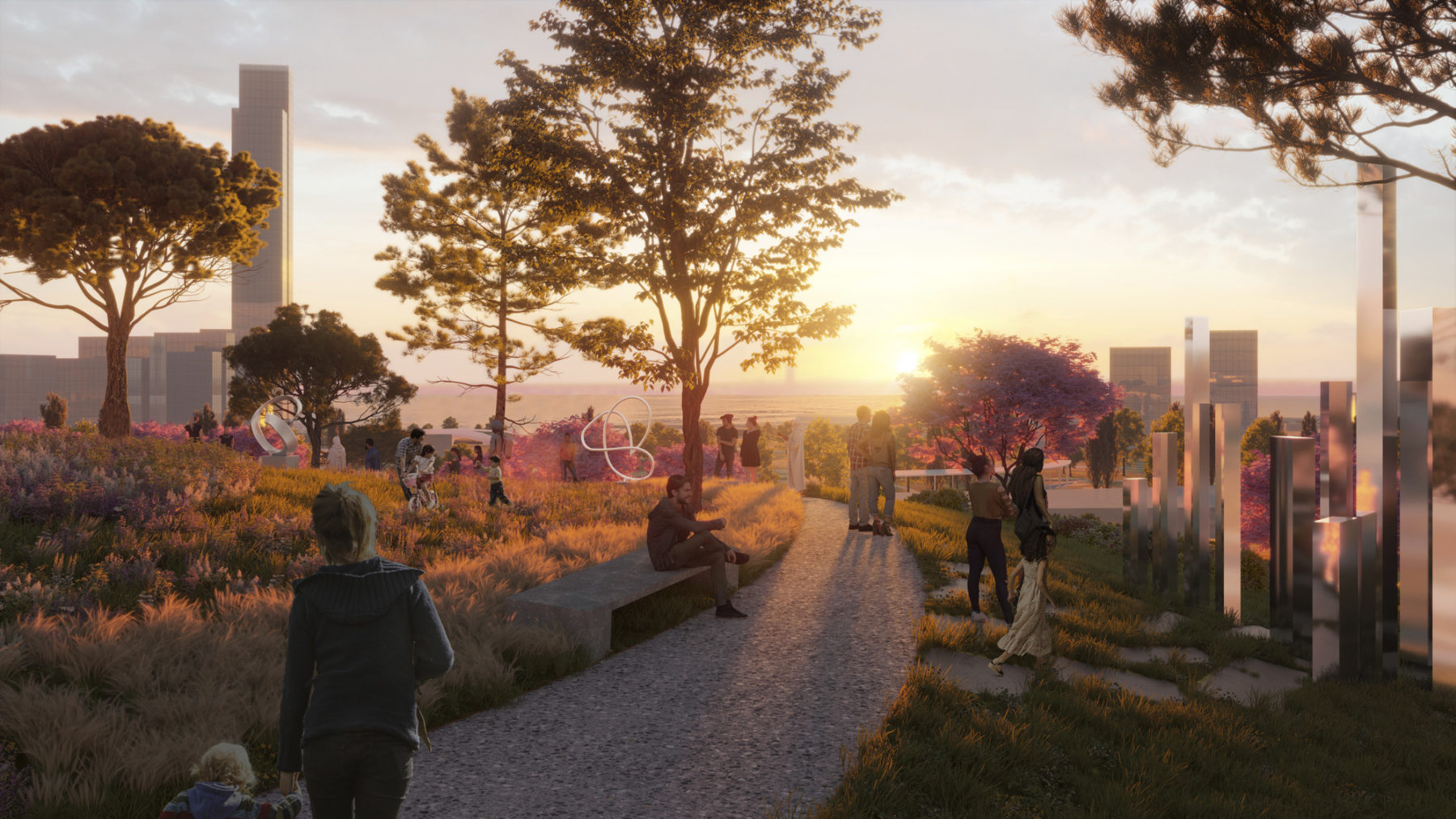
Meandering paths ascend through the topography and provide intimate moments to connect with installations by local artists, leading to sweeping views of the entire park and out to the sea from the summit
For more information contact Michael Grove or Anna Cawrse.
The Ellinikon Park will be a new social, recreational, and ecological hub for Athens, Greece
The park presents a once-in-a-generation opportunity to transform obsolete infrastructure into a climate-positive public landscape